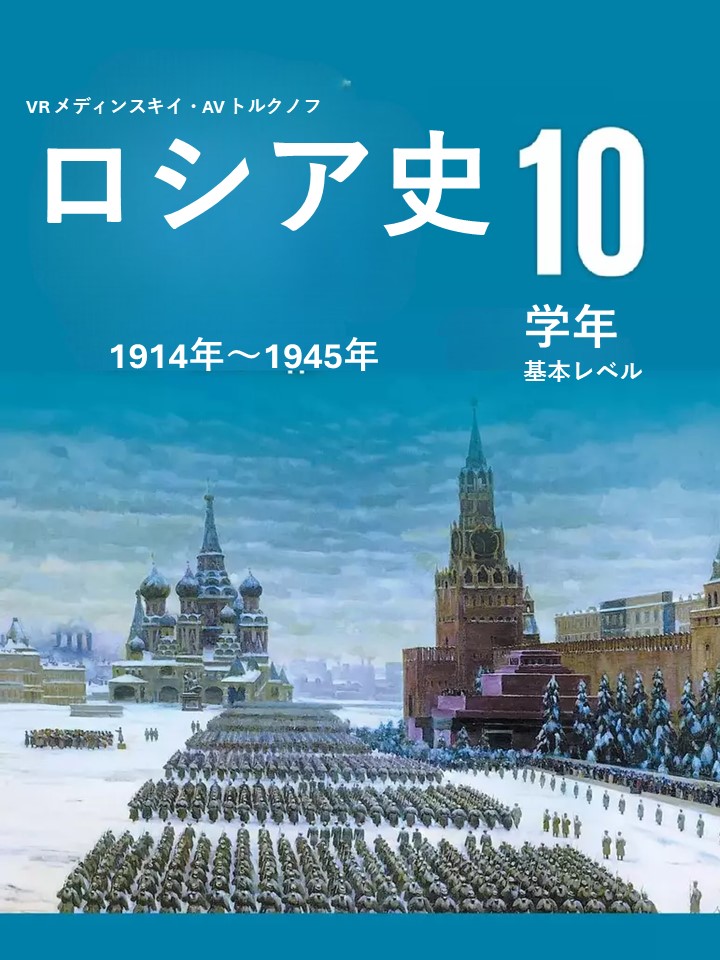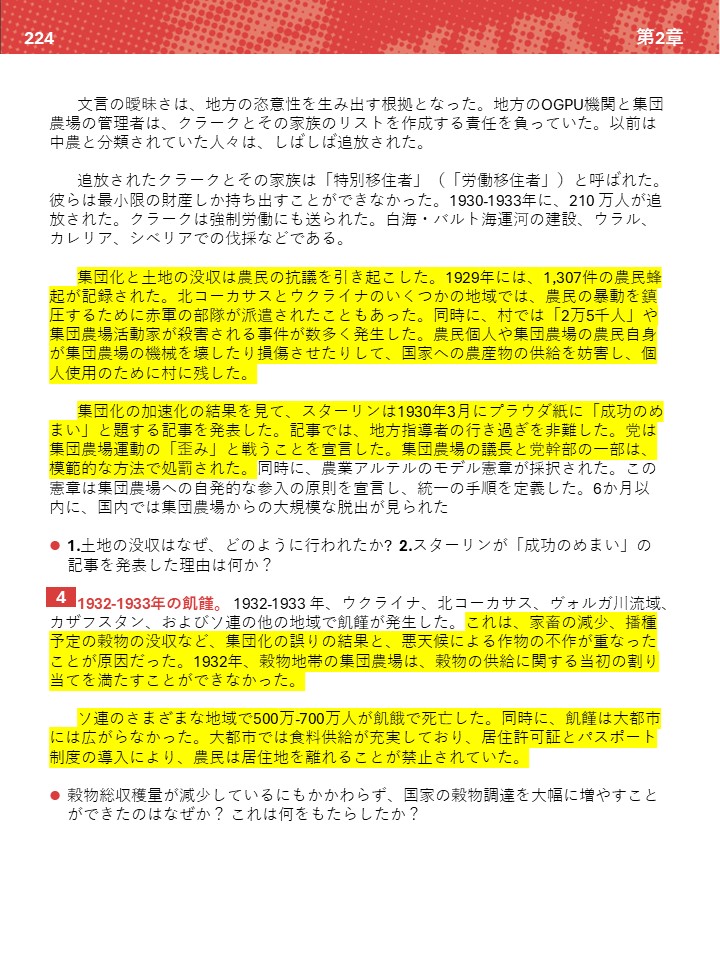ロシア右翼, ロシア史教科書
2022年からの「特別軍事作戦」に合わせて改訂された「ロシア史教科書 (11学年 1945-21世紀初頭)」とともに、その前半である「ロシア史教科書 (10学年 1914-1945年)」も改訂されている。その中では、主としてスターリンをホワイトウォッシュしている。
そのひとつが「§20 農業の集団化」でわずかに触れている「ソビエト大飢饉 (1932年-1933年)」である。
これについて、Anya Freeが述べているように、スターリンはホワイトウォッシュされている。
餓死者500〜700万という数字だけは妥当ではあるが...
もちろん、スターリンがウクライナで意図的に飢餓で殺しにかかっていたことも描かれることはない。
2022年からの「特別軍事作戦」に合わせて改訂された「ロシア史教科書 (11学年 1945-21世紀初頭)」とともに、その前半である「ロシア史教科書 (10学年 1914-1945年)」も改訂されている。その中では、主としてスターリンをホワイトウォッシュしている。
そのひとつが「§20 農業の集団化」でわずかに触れている「ソビエト大飢饉 (1932年-1933年)」である。
これについて、Anya Freeが述べているように、スターリンはホワイトウォッシュされている。
The new school textbooks maintain some nuance in their coverage of Stalinism, yet that nuance can be described as “yes, but,” which makes it even more effective in warping the historical narrative.
The 10th grade Russian history textbook, for example, briefly mentions the dramatic consequences of collectivization of Soviet agriculture, including the 1932-33 man-made famines in Ukraine, Kazakhstan, North Caucasus and other regions. Yet it puts the blame exclusively on the poor harvests and mistakes of the local leadership rather than the Stalinist policies that caused and exacerbated the famines. Ukraine’s great famine, or Holodomor, in particular is considered by many historians and international organizations to be a genocide.
新しい学校の教科書はスターリン主義の記述に多少のニュアンスを残しているが、そのニュアンスは「YES, BUT」と表現でき、歴史の物語を歪曲するのにさらに効果的である。
たとえば、10年生のロシアの歴史教科書は、ウクライナ、カザフスタン、北コーカサス、その他の地域で1932年から33年にかけて発生した人為的な飢饉など、ソ連の農業の集団化の劇的な結果について簡単に触れている。しかし、飢饉を引き起こし、悪化させたスターリン主義の政策ではなく、不作と地元指導者の失策のみを非難している。特にウクライナの大飢饉、いわゆるホロドモールは、多くの歴史家や国際機関によって大量虐殺と見なされている。
[ Anya Free: "Back in the USSR: New high school textbooks in Russia whitewash Stalin’s terror as Putin wages war on historical memory" (2024/01/23) on The Conversation ]
餓死者500〜700万という数字だけは妥当ではあるが...
Throughout, our conclusions are based either on exact and certain figures, or on reasonably conservative assumptions. So when we conclude that no fewer than fourteen million odd peasants lost their lives as a result of the events recounted in this book we may well be understating. In any case, the eleven million odd excess dead shown by the 1937 census is hardly subject to serious amendment. The famine figures seem both reasonable in themselves and consonant with the census's shortfall; as do the dekulakization figures.ここにある「クラーク階級の粛清による死者: 650万人」には教科書は触れていない。
全体を通して、我々の結論は正確で確実な数字、またはかなり控えめな仮定に基づいている。したがって、この本で述べられている出来事の結果として少なくとも1,400万人以上の農民が命を落としたと結論付けた場合、それは控えめな数字である。いずれにせよ、1937年の国勢調査で示された1,100万人以上の過剰死者数は、ほとんど修正の余地がない。飢餓の数字は、それ自体が妥当であり、国勢調査の不足数と一致しているように見える。「クラーク階級の粛清」の数字も同様である。
Why we cannot be more exact is obvious. As Khrushchev says in his memoirs, 'I can't give an exact figure because no one was keeping count. All we knew was that people were dying in enormous numbers'.
正確な数値が得られない理由は明らかである。フルシチョフが回想録で述べているように、「誰も数えていなかったので、正確な数字を示せない。膨大な数の人々が死んでいることはわかっていた。」
...
Peasant dead (農民の死者): 1930-37 ... 11 million
Arrested in this period dying in camps later (逮捕され収容所での死者) ... 3.5 million
TOTAL ... 14.5 million
Of these:
Dead as a result of dekulakization (クラーク階級の粛清による死者) ... 6.5 million
Dead in the Kazakh catastrophe (カザフのカタストロフ)....... 1 million
Dead in the 1932-3 famine (1932-33年の飢餓の死者):
in the Ukraine (ウクライナ)................... 5 million
in the N. Caucasus (北カフカース)............... 1 million
elsewhere (その他)........................ 1 million
As we have said, these are enormous figures, comparable to the deaths in the major wars of our time. And when it comes to the genocidal element, to the Ukrainian figures alone, we should remember that five million constitutes about 18.8% of the total population of the Ukraine (and about a quarter of the rural population). In World War I less than 1% of the population of the countries at war died. In one Ukrainian village of 800 inhabitants (Pysarivka in Padilla), where 150 had died, a local peasant ironically noted that only seven villagers had been killed in World War I."
既に述べたように、これらは膨大な数字であり、現代の大戦争での死者数に匹敵する。そして、大量虐殺の要素について言えば、ウクライナの数字だけを見ても、500万人はウクライナの総人口の約18.8%(そして農村人口の約4分の1)を占めていることを忘れてはならない。第一次世界大戦では、戦争に参加した国の人口の1%未満が死亡した。150人が死亡したウクライナのある村(パディラのピサリウカ)では、皮肉にも、第一次世界大戦で死亡した村人はわずか7人だったと地元の農民が述べた。
[Robert Conquest: "The Harvest of Sorrow -- Soviet Collectivisation and the Terror-Famine", 1986, pp.305-306]
もちろん、スターリンがウクライナで意図的に飢餓で殺しにかかっていたことも描かれることはない。
- 集団化はソ連全土で失敗していたが、最も多くの犠牲者が出たのはソヴィエト・ウクライナ。
- 1932年、ウクライナの農民は収穫の余剰分をすべて国家に返還させられ、何度も捜索と虐待を受けた。
- 穀物を納められなかった農民は肉で特別税を支払わされ、家畜を奪われた。
- 割当量未達成の農場は「ブラックリスト」に載り、全財産を奪われ、商取引や物資の入手が禁止された。
- 1932年12月、スターリンの指示でウクライナの共産党員が粛清され、民族主義者との結びつきがでっちあげられた。
- 1933年初頭、ウクライナの農村は封鎖され、農民は都市部や他の地域に逃げられなくなった。
- 徴発目標達成後も穀物収奪は続き、種子まで奪われたため、農場は栽培不能となった。
- スターリンは飢饉を意図的に放置し、約300万人が餓死する結果を招いた。
- ウクライナ全土で飢饉が拡大し、飢えた農民が故郷に強制的に送り返された。
- 徴発に関わった党員たちは恐怖や信念に基づき、飢饉を引き起こす行為に加担した。
 ロシア史1945-21世紀 (日本語) |  ロシア史1914-1945 (§13〜28) (日本語) |



コメントをかく